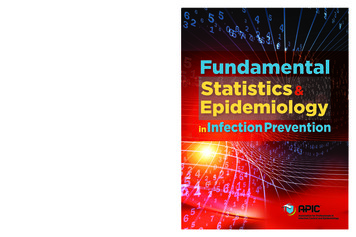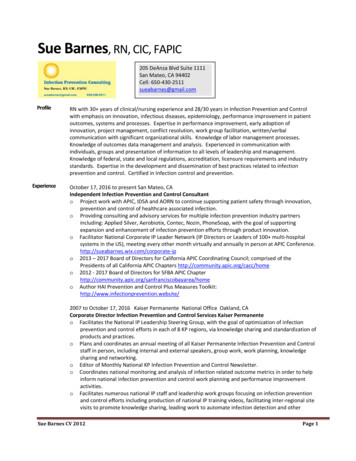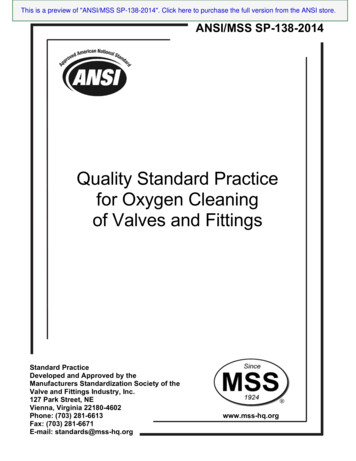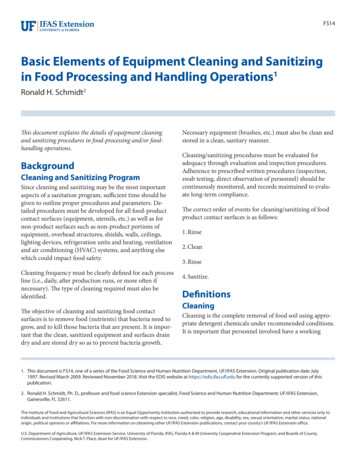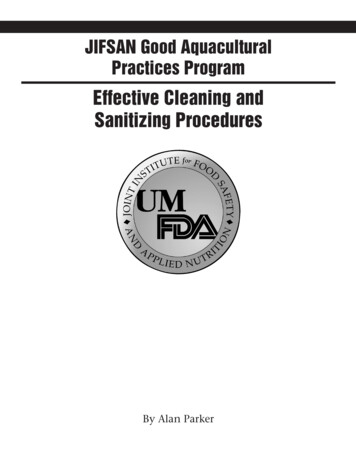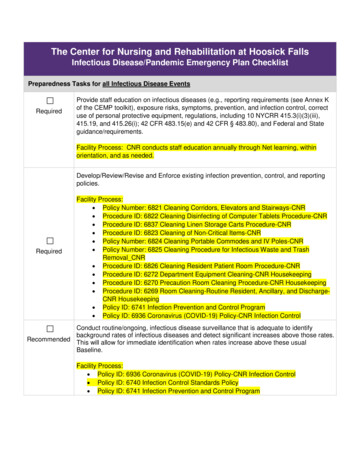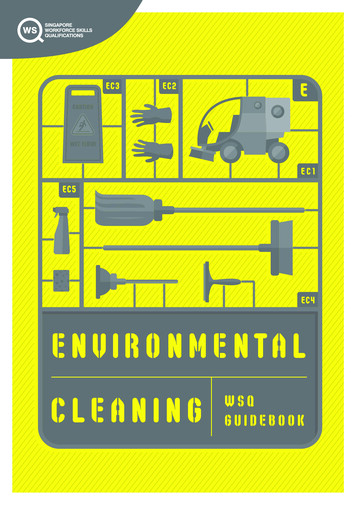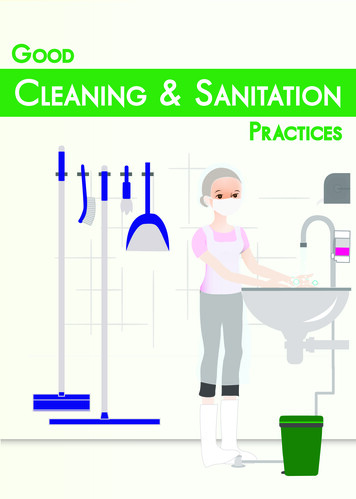
Transcription
3/13/20191Keeping Ophthalmic Instruments SafeNancy Chobin, RN, AAS, ACSP, CSPM, CFERCEO Sterile Processing UniversityLebanon, NJCopyright 20192Objectives Identify AAMI recommended cleaning protocols to prevent TASS Review the AAMI preparation recommendations for instruments and sets Review care and handling of ophthalmic instruments3Background Time to perform a cataract procedure has decreased15-20 minutes. The cost for a set of instruments can range from 6,000 to 8,000 or more Urgency to turn the instruments around for the next case. Instruments come in contact with the eye and thus body fluids. They are considered contaminated and must receive the entire cleaning andsterilization process between patients. 4Manufacturer’s Instructions Instrument manufacturer should: specify the pH of detergent (e.g. neutral pH) may recommend a pre-soak in an enzymatic cleaner to help remove protein soils(e.g. body fluids) specify if any special cleaning implements are needed (e.g. to clean out lumens). Specify water quality for cleaning and rinsing However, need to reconcile this information with AAMI and ASORN, AORN, ASCRS andthe CDC. 5Manufacturer’s Instructions Also known as Instructions for Use (IFUs) Keep on file - readily available to processing personnel. Ensure IFUs followed each and every time the instrument is processed. Employee training should complement the AAMI guidelines as well as manufacturers’instructions Eye instrumentation is extremely delicate and as such requires very special handlingand processing to prevent damage. All personnel handling eye instrumentationshould ensure careful handling.6Example of Steam Sterilization IFU Prevacuum High Temperature Autoclave: 274 F (134 C) for 3 minutes; wrapped. NOTE: As per ANSI/AAMI ST79:2010 and A1:2010 270 F (132 C) for 4 minutes and275 F (135 C) for 3 minutes are acceptable minimum cycle times for dynamic-airremoval steam sterilization cycles. Standard Gravity Autoclave: 250 F (121 C) for 30 minutes; wrapped. High Speed (Flash) Autoclave: 270 F (132 C) for 10 minutes; unwrapped.7Training and Competencies Employee competencies should be verified in the processing protocols for processingophthalmic instruments Competencies should be verified initially and annually Utilize resources such as ophthalmic instrument company's educational materials1
NOTE: As per ANSI/AAMI ST79:2010 and A1:2010 270 F (132 C) for 4 minutes and275 F (135 C) for 3 minutes are acceptable minimum cycle times for dynamic-airremoval steam sterilization cycles. Standard Gravity Autoclave: 250 F (121 C) for 30 minutes; wrapped. High Speed (Flash) Autoclave: 270 F (132 C) for 10 minutes; unwrapped.73/13/2019Training and Competencies Employee competencies should be verified in the processing protocols for processingophthalmic instruments Competencies should be verified initially and annually Utilize resources such as ophthalmic instrument company's educational materials Reconcile with national standards89Cleaning Removal of contamination from an item to the extent necessary for further processingor for the intended use. Involves the use of detergent and water, of adherent visible soil (i.e. blood, pus,protein) from the surfaces, crevices, serrations, jaws and lumens of instruments,devices and equipment, by a manual or mechanical process. Due to their design, eye instrument challenging to clean Very small lumens, very delicate tips, can easily break/damage 10Pre-Cleaning in Room Treat with demineralized water to prevent drying of bioburden. Saline, disinfectants, and chlorinated solutions can cause pittingand corrosion and should never be used for soaking instruments Instruments should not remain in water for lengthy periods of time. –– Biofilms may form, particularly within lumens.11Decontamination According to OSHA, “the use of physical or chemical means to remove, inactivate, ordestroy blood-borne pathogens on a surface or item to the point where they are nolonger capable of transmitting infectious particles and the surface or item is renderedsafe for handling, use, or disposal.” [29 CFR 1910.1030] NOTE—Generally used in health care facilities to refer to all pathogenic organisms,not just those transmitted by blood First and most critical step in breaking the chain of disease transmission12Why Is Cleaning Important? Process of disinfection or sterilization dependent upon direct contact of the sterilant ordisinfectant with the surface of the item Protein left on items can be “baked on” in the sterilizer Why are some facilities only “wiping off” the instruments? “Cleaning with water?Alcohol?13TASS – Focus Toxic Anterior Segment Syndrome (TASS) – main focus by AAMI and AORN TASS - an acute inflammatory response of the anterior chamber of the eye. May lead to severe visual impairment if it is not recognized and treated in a timelymanner. Many causes including detergents, water quality, steam quality, instruments, etc. Major concern is when endotoxins form 14Causes of TASS (ASCRS)* Detergent residues (in general)2
TASS - an acute inflammatory response of the anterior chamber of the eye. May lead to severe visual impairment if it is not recognized and treated in a timelymanner. Many causes including detergents, water quality, steam quality, instruments, etc. Major concern is when endotoxins form 14Causes of TASS (ASCRS)* Detergent residues (in general) Endotoxins Preservatives Residues from sterilization processing Residues of detergents inside a reusable cannula or instrument Cement sealant on bags of irrigating solution which has leached out All can induce TASS and cause severe damage to ocular tissue * American Society of Cataract and Refractive Surgeons 15TASS Particular care must be taken in the processing of intraocular surgical instruments tohelp ensure that foreign substances or materials associated with the instruments willnot be introduced into the anterior chamber of the eye during surgery. 16TASS Outbreaks of TASS have often been linked to the failure to follow the processingprocedures recommended by the instrument manufacturer Specific instrument cleaning and sterilization recommendations intended to diminishthe risk of TASS associated with intraocular surgical instruments have been publishedby the American Society for Cataract and Refractive Surgery (ASCRS, 2006). Also in AAMI ST-79 as an Annex 17ASCRS Recommendations An adequate inventory of the necessary intraocular surgical instruments should bemaintained in order to allow for the timely processing of instruments between cases. Major issue in surgery centers Insufficient inventory of instruments leads to short cuts in cleaning18ASCRS Recommendations Adequate time must be allowed for processing instruments according to themanufacturer’s instructions; otherwise, the cleaning and sterilization of theinstruments will be ineffective.3/13/2019 19ASCRS Recommendations A designated cleaning area and equipment specific to the cleaning of intraocularsurgical instruments should be identified. Whenever possible, intraocular surgical instruments should be processed separatelyfrom general surgical instruments and equipment in order to reduce the potential forcross-contamination by material or residue from the general surgical instruments 20ASCRS Recommendations Instruments should be pre-cleaned immediately following use. Gross debris should be removed, and instrument lumens should be flushed withsterile distilled water or another suitable agent as recommended in the room at theend of the procedure3
surgical instruments should be identified. Whenever possible, intraocular surgical instruments should be processed separatelyfrom general surgical instruments and equipment in order to reduce the potential forcross-contamination by material or residue from the general surgical instruments 20ASCRS Recommendations Instruments should be pre-cleaned immediately following use. Gross debris should be removed, and instrument lumens should be flushed withsterile distilled water or another suitable agent as recommended in the room at theend of the procedure 21ASCRS Recommendations Only cleaning agents that have been recommended by the manufacturer should beused. Particular attention should be paid to the specified concentration of cleaning agentand to the recommended water quality.22ASCRS Recommendations Final rinsing of the instrument should be performed with sterile, distilled, or deionizedwater, unless otherwise specified by the manufacturer. The water used to clean or rinse instruments should be discarded after each use. 23ASCRS Recommendations If an ultrasonic cleaner is used to process the instruments, it should be emptied,cleaned, rinsed, and dried at least daily or, preferably, after each use. Brushes and other cleaning tools should be cleaned and sterilized as recommended bythe manufacturer at least daily or, preferably, after each use. 24ASCRS Recommendations Cleaning and sterilization equipment should be properly maintained. Foreign materials such as endotoxin or heavy metals may be deposited onto theinstruments during processing and induce TASS25Water Quality Water used to for the final rinse of the device should have a low endotoxin content toavoid pyrogens on processeddevices. Can lead to pyrogenic reactions (i.e., fever) in patients. Adequate cleaning and rinsing should result in low bioburden Essential to the effectiveness of terminal sterilization and to the protection ofpatients from pyrogens.26Physical Area Separate area – dedicated to cleaning of ophthalmic instruments Away from any other type of surgical instruments Temp 60-65oF Humidity 30-60% Air exchanges 10/hour negative Monitor temperature and humidity daily and document27FIRST STEP Must have manufacturer’s instructions for cleaning of all devices; method, implementsand chemicals recommended28Steps in the Cleaning Process Pre-Cleaning in room3/13/20194
Away from any other type of surgical instruments Temp 60-65oF Humidity 30-60% Air exchanges 10/hour negative Monitor temperature and humidity daily and document27FIRST STEP Must have manufacturer’s instructions for cleaning of all devices; method, implementsand chemicals recommended28Steps in the Cleaning Process Pre-Cleaning in room Contain contaminated items at the point of use Transport to Decontamination (confined and contained) Sort Soak Wash Rinse/Dry29Pre-Cleaning - Transport Instruments should be pre-cleaned immediately following use Remove gross debris and flush lumens with sterile distilled water (or other agent asrecommended by the instrument manufacturer) Keep instruments moist to avoid drying of soils Many now recommend cleaning immediately or within 30 minutes of use Transport in closed container (confine/contain) Container should be labeled as biohazard (OSHA)30Soaking Can pre-soak with a detergent Use of enzyme detergents preferred – but only if recommended by the instrumentmanufacturer Assists in the loosening of soils to facilitate cleaning Do NOT soak in fluids for prolonged periods of time - biofilms can form Generally form on any surface that is exposed to non-sterile water or other liquidsand is consistently found in many environments including industrial and medicalsystems use enzymatic gels or foam31Biofiolms Are produced by microorganisms and consist of a sticky rigid structure of organiccontaminates Slime layer anchored firmly to a surface and provides a protective environment formicroorganisms to grow 32Cleaning Need to take special precautions with eye instruments due to Delicate nature of the design Sensitivity of eye tissue Cleaning becomes a challenge Manual cleaning may be only validated method Manual cleaning is not as controlled (standardized) as mechanical cleaning 33Dilemma Some eye instrument manufacturer’s do not recommend ANY detergent Source of confusion for end user3/13/20195
Delicate nature of the design Sensitivity of eye tissue Cleaning becomes a challenge Manual cleaning may be only validated method Manual cleaning is not as controlled (standardized) as mechanical cleaning 33Dilemma Some eye instrument manufacturer’s do not recommend ANY detergent Source of confusion for end user Need to challenge manufacturers34Enzymatic Cleaners Organic substances which assist in the breakdown of soils Facilitate the removal of blood and protein soils Excellent for devices with lumens Effectiveness dependent upon concentration, use temperature and contact time35Enzymatic Cleaners Sold as liquid concentrates or powder Generally more effective in warm water (110-140oF) Enzyme activity can be inactivated above certain maximum temperatures (140 oF) Follow manufacturer’s directions Use a thermometer – monitor water temperature36Principles of Cleaning Must have manufacturer’s written instructions for cleaning of all devices processed Follow all recommended steps using equipment recommended Must wear PPE Impervious gown, head cover, shoe covers, cuffed gloves, face shield37Manual Cleaning Process May be the only cleaning process available Items should be submerged, disassembled Preferable to use 3-sink method; wash, rinse, rinse Can also be used to remove deposits which were not removed during the pre-soak Brush all serrations, crevices, tips, handles, and hinges. Brushing should be done under the surface of the water to prevent aerosolization ofcontaminants.38Manual Cleaning – General Instructions Handle instruments one at a time or in small numbers to avoid damage Open hinged instruments Disassemble multi-part instruments – keep parts together for easy reassembly aftercleaning Brush and flush all lumened devices Clean all surfaces 39Specialty Items Cannulas, irrigation cannulas,irrigation/aspiration (I/A) handpieces, suction tips,cystotomes. Use a brush of the appropriate size to clean the lumen; hold instrument and brushbelow the water surface40Manual Cleaning Detergents Usually used for manual cleaning and as a pre-soak Range from low foam to high foam products Generally have neutral pH of 7 to 93/13/20196
39Specialty Items Cannulas, irrigation cannulas,irrigation/aspiration (I/A) handpieces, suction tips,cystotomes. Use a brush of the appropriate size to clean the lumen; hold instrument and brushbelow the water surface40Manual Cleaning Detergents Usually used for manual cleaning and as a pre-soak Range from low foam to high foam products Generally have neutral pH of 7 to 9 Sold as concentrates Free rinsing Always measure and dilute the detergent as specified by the detergent manufacturer Water used to clean instruments should be discarded after each use 41Manual Cleaning Implements Soft bristle brushes, various sizes and lengths (no metal brushes) Soft cloths No abrasive items No sponges No materials which are permeable; i.e. Wood Implements used to clean instruments should be cleaned according to themanufacturer or at least daily, preferably after each use42Mechanical Cleaners Do not put microsurgical instruments into a washer decontaminator unless it has adelicate cycle. Can result in damage to instruments43Specialty Cleaner Specialty cleaning and rinsing system for lumened devices such as Phaco and OZILhandpieces Effectively cleans and rinses lumens Must disinfect according to IFUs and document44Diamond Knives The diamond knife is designed to make precision atraumatic cuts The diamond knife has the sharpest cutting edge possible Cost can range from 800 - 2,500 or more45Diamond Blade Knives Cleaning: Immediately after using a diamond knife, the blade must be rinsed withdemineralized water, preventing cell particles or viscoelastic materials from sticking tothe blade. Generally. ultrasonically clean holding the knife and suspending only the blade intothe fluid. The blade should not touch any other instruments or the sides of the cleaner.46Diamond Blade Knives Never completely submerge a diamond knife in an ultrasonic cleaner. At all time, (except cleaning) the blade should be in the retracted position to preventdamage. Inspect with microscope.47Ultrasonic Cleaning Uses sound waves transmitted through a solution3/13/20197
The blade should not touch any other instruments or the sides of the cleaner.46Diamond Blade Knives Never completely submerge a diamond knife in an ultrasonic cleaner. At all time, (except cleaning) the blade should be in the retracted position to preventdamage. Inspect with microscope.47Ultrasonic Cleaning Uses sound waves transmitted through a solution Sound waves produce tiny bubbles which implode - results in scouring action thatcleans Mechanical process cavitation48Ultrasonic Cleaning Effective to remove soils in hard-to-reach areas (box locks, mouth teeth, etc.) Generally can only use detergents specifically formulated for ultrasonic cleaners - lowfoaming Water temperatures usually 100 - 140 o F. Can be used after manual cleaning 49Ultrasonic Cleaning Solution should be changed at least daily preferably after each use Outbreaks of TASS have been associated with contaminated sonic baths Unit should have a cover to contain aerosols Items should not be stacked Need to “de-gas” water50Ultrasonic Cleaning Containers/baskets should have perforations; should be all metal mesh; no plastic Should be located in Decontamination Area cleaning process more efficient than manual cleaning Test the sonic for efficacy (daily?)51Testing Sonic52Rinsing The most important part of the cleaning process Essential to remove loosened debris Should be performed with the volume and quality (sterile, distilled, or deionized water(if manual cleaning) Water used to rinse instruments should be discarded after each use Sterile distilled water recommended for final rinse to prevent mineral deposits andTASS53Lubrication The use of instrument milk is beneficial to instruments to prevent corrosion and tokeep moving parts from getting stiff. However, not all instruments should be lubricated. The instrument manufacturer willindicate if this process is recommended. 3/13/20195455Principles of Inspection/Assembly All items should be prepared according to the device manufacturer’s writteninstructions (i.e. must the device be disassembled for sterilization?)8
The use of instrument milk is beneficial to instruments to prevent corrosion and tokeep moving parts from getting stiff. However, not all instruments should be lubricated. The instrument manufacturer willindicate if this process is recommended. 3/13/20195455Principles of Inspection/Assembly All items should be prepared according to the device manufacturer’s writteninstructions (i.e. must the device be disassembled for sterilization?) All hinged instruments should be in the open position to permit the sterilant tocontact all surfaces of the jaws, blades, etc. Items must be checked for cleanliness – the use of a lighted magnifying lamp isrecommended to visualize defects such as cracked box locks, soils or missing tips.56Inspection Best method is to use a microscope 57Principles of Inspection/Assembly All parts are present and functional Use perforated or mesh bottom trays All scissors should be tested for sharpness each time they are processed Test that ratchets hold on clamps Inspect hand held forceps that tips approximate Test needle holders; ratchets hold and tips hold suture needle 58Principles of Inspection/Assembly Inspect that joints are not stiff Use a lighted magnifying lamp or microscope to inspect Inspect for rust, pitting, cracked box lock, etc. Demagnetization of eye instruments may be needed Separate delicate, sharp items Use non-linting surgical towels, or paper sterilization bags to separate items insideset; not peel pack material Refer to manufacturer’s IFUs regarding flushing of all lumened devices (AAMI statesonly for gravity cycles). Use sterile, distilled water 59Ophthalmic Instruments Look for defects: Rusting common (especially if IUSS frequently used Corrosion Damage to tips/ teeth Cords Lumens (e.g. Phaco handpieces) Stiffness Sharpness60Spotting – Staining - Rust61Delicate Tips Require Protection Can use small containers with silicone mat for individual instruments to provideprotection.9
Damage to tips/ teeth Cords Lumens (e.g. Phaco handpieces) Stiffness Sharpness60Spotting – Staining - Rust61Delicate Tips Require Protection Can use small containers with silicone mat for individual instruments to provideprotection.62General Guidelines for Packaging Instrument Sets Use specialty containers to keep delicate instruments in place and prevent damagein transport and cleaning. The single most effective means to prevent damage to eye instruments is to placethem in specialty protective containers The basket or container of the correct size to prevent instrument damage 63Handling Eye Instruments Place instruments in the tray so that they do not touch each other. Locate each instrument in the tray to prevent movement and possible damage duringhandling. Always keep delicate tips protected with a tip guard when the instrument is not inuse.64Protective Container - Cataract Set65Finger Mats May Not Provide Adequate Protection66Paper Plastic Pouches Widely used because of the visibility of the contents. However, according to AAMI and AORN pouches should be used for 1-2, light weightinstruments. If packaging instruments separately, select the correct size pouch. Allow approximately 1” distance from the device and the pouch edges. Must ensure instruments packaged to protect from damage67General Guidelines for Packaging Individual Instruments/Small Items Use correct size packaging Do not use rubber bands to secure instruments68Paper Plastic Pouches Double pouching is not required (AORN, AAMI) May be used for small items which would be difficult to keep together If double pouching, do not fold over the edges of inside pouch Inside pouch must lay flat 69Tip Protectors Obtain the manufacturer’s instructions for use. Some can “catch” onto the instruments – can result in damage You can use any tip protector that has been approved for use in a sterilization system;foam sleeves, plastic; paper/plastic. Make sure device can be held open with protector on (e.g. scissors, clamps). Must have manufacturer’s data that sterilant will penetrate through the tip protector. 3/13/201910
69Tip Protectors Obtain the manufacturer’s instructions for use. Some can “catch” onto the instruments – can result in damage You can use any tip protector that has been approved for use in a sterilization system;foam sleeves, plastic; paper/plastic. Make sure device can be held open with protector on (e.g. scissors, clamps). Must have manufacturer’s data that sterilant will penetrate through the tip protector. 70Chemical Indicators (Types) External (Type I) – used to distinguish an item that has been in a sterilizer from anitem that has not Internal chemical indicators (Type 3-4-5) Should be used inside and outside each package. For wrapped sets, the internalchemical indicator should be located in the center of the pack, not the top. Type 3 – responds to one parameter Type 4 – responds to 2 or more parameters Should use at least a Type 4 CI 3/13/2019 71Chemical Indicators Type 5 – integrating indicators – correlate to the action of a biological test Cannot substitute for a BI test Type 6 – emulating indicators that respond to a specific cycle type, temperature andexposure time 7273Labeling Packages Use a marking pen containing non-toxic, permanent ink and approved for theintended process (e.g., steam sterilization cycles). Need documentation that marker is non-toxic. Packages - label on the indicator tape used to close the package, never on thewrapping material itself. Paper–plastic pouches - label only on the plastic side or on sterilization tape. If a package is labeled directly on the packaging material, themarker could damage the packaging material. Exception is the plastic side of paper plastic pouches. 7475Table Top Sterilizers Many ASCs use table top sterilizers A table-top sterilizer is a ”compact steam sterilizer that has a chamber volume of notmore than two cubic feet and that generates its own steam when distilled ordeionized water is added by the user” (ANSI/AAMI ST79). Table-top sterilizers -commonly found in smaller surgery centers where a highvolume of sterilization processing does not take place. Also found in doctors’ and dental offices.76Cycles The device manufacturer’s sterilization instructions should always be followed11
75Table Top Sterilizers Many ASCs use table top sterilizers A table-top sterilizer is a ”compact steam sterilizer that has a chamber volume of notmore than two cubic feet and that generates its own steam when distilled ordeionized water is added by the user” (ANSI/AAMI ST79). Table-top sterilizers -commonly found in smaller surgery centers where a highvolume of sterilization processing does not take place. Also found in doctors’ and dental offices.76Cycles The device manufacturer’s sterilization instructions should always be followed If the cycles provided by the sterilizer cannot be adjusted to conform to the devicemanufacturer’s instructions, the device should not be processed in that sterilizer.77Conventional Steam Sterilizers Read the IFUs for exposure time, temperature and cycle time Many have CJD cycles ONLY Many have European temperatures only (e.g. 273oF) Must reconcile IFU information May have to separate sets to meet IFUs E.g. some instruments require 10 minutes exposure78Water Quality Water quality is just as important for table-top units as for sterilizers that use boilergenerated steam. Distilled or deionized water is recommended to prevent the buildup of minerals in thereservoir and on processed devices. Each day, before the sterilizer is used for the first time, the reservoir should bechecked to ensure that there is enough water for the number of loads to beprocessed. 79Maintenance Perform all the recommended maintenance of the tabletop sterilizer Document all maintenance (e.g. reservoir cleaned, gaskets cleaned, etc.80Documentation All cycles run should be documented All items processed must be documented Specific name of device/tray Quantity All items must be identified with a lot control number (to facilitate recall) Must include date sterilized, sterilizer #, load number Expiration date or event related statement Traceability to the patient if posterior eye tissue surgery (CJD)81Summary Best practices for processing ophthalmic instruments requires knowledge of thestandards and recommendations to prevent TASS Manufacturers IFUs Effective cleaning Correct packaging methods and materials Effective sterilization – Processing equipment in good condition Proper handling after sterilization Monitoring of staff compliance with all stated policies and manufacturers’instructions Training and competencies for staff823/13/201912
Manufacturers IFUs Effective cleaning Correct packaging methods and materials Effective sterilization – Processing equipment in good condition Proper handling after sterilization Monitoring of staff compliance with all stated policies and manufacturers’instructions Training and competencies for staff82Conclusion - The End Successful patient outcomes require we develop effective policies, train staff andmonitor for compliance Careful handling of ophthalmic instruments will keep patients safe and reduce costs.83References AAMI. Comprehensive Guide to Steam Sterilization and Sterility Assurance in HealthCare Facilities. ST-79, 2017. AORN. Standards and Recommended Practices. “Selection and Use of PackagingSystems”, AORN. Centers for Disease Control (Hospital Infection Control Guidelines) 2008 American Society of Cataract & Refractive Surgeons. White Paper on TASS (2006). The Basics of Sterile Processing textbook, 6th edition, Sterile Processing University,2016. 84Questions?3/13/201913
NOTE: As per ANSI/AAMI ST79:2010 and A1:2010 270 F (132 C) for 4 minutes and 275 F (135 C) for 3 minutes are acceptable minimum cycle times for dynamic-air- . Cleaning: Immediately after using a diamond knife, the blade must be rinsed with demineralized water, preventing cell particles or viscoelastic materials from sticking to
